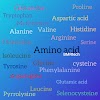Arginine | Introduction | History | Applications....
ARGININE AMINO ACID
Introduction-
Arginine, also known as l-arginine is an essential α-amino acid. It is used in the biosynthesis of proteins. It contains an α-amino group and α-carboxylic acid group. A
side chain consisting of a 3-carbon aliphatic straight chain ending in
a guanidine group. At
physiological pH, the carboxylic acid is deprotonated (−COO−), the
amino group is protonated (−NH3+). The guanidino group is also protonated to
give the guanidinium form (-C-(NH2)2+).
It is the precursor for the biosynthesis of nitric oxide. It is encoded by
the codons CGU, CGC, CGA, CGG, AGA, and AGG.
Arginine is classified as a semiessential or conditionally essential amino acid. Preterm infants are unable to synthesize or create
arginine internally, making the amino acid nutritionally essential for them.
Most healthy people do not need to supplement with arginine because it is
a component of all protein-containing food and can be synthesized in the
body from glutamine via citrulline.
Properties-
Chemical formula :- C6H14N4O2
Molar mass :- 174.204 g·mol−1
Appearance :- White crystals
Odor :- Odourless
Melting point :- 260 °C; 500 °F; 533 K
Boiling point :- 368 °C (694 °F; 641 K)
Thermodynamic data :- Phase behaviour (solid–liquid–gas)
Structure-
Arginine was first discovered in 1886
from yellow lupin seedlings by the
German chemist Ernst Schulze and
his assistant Ernst Steiger. He named it from the "silver" due
to the silver-white appearance of arginine nitrate crystals. In 1897,
Schulze and Ernst Winterstein (1865–1949) determined the structure of
arginine. Schulze and Winterstein synthesized arginine from ornithine and cyanamide in
1899.
Sources-
Dietary
sources-
Arginine is a conditionally essential amino acid in humans and
rodents. It may be required depending on the health status or lifecycle of the
individual. When the small intestine and kidneys which are the major sites of arginine biosynthesis, have
been damaged.
Animal sources of arginine include meat, dairy products, and
eggs and plant sources include seeds of all types, for example grains, beans,
and nuts.
Biosynthesis-
Arginine is synthesized from citrulline in arginine
and proline metabolism by the sequential action of the cytosolic enzymes argininosuccinate
synthetase and argininosuccinate lyase. This is an energetically
costly process, because for each molecule of argininosuccinate that
is synthesized, one molecule of adenosine triphosphate (ATP) is hydrolyzed to adenosine monophosphate (AMP), consuming two ATP equivalents.
Citrulline can be derived from multiple sources.
Arginine
biosynthesis-
Whole-body basis, synthesis of arginine occurs principally via
the intestinal–renal axis. The epithelial cells of
the small intestine produce
citrulline, primarily from glutamine and glutamate. which is carried in the bloodstream to the proximal
tubule cells of the kidney, which extract citrulline from the circulation and
convert it to arginine, which is returned to the circulation.
Structure- The amino acid side-chain of arginine consists of a 3-carbon aliphatic straight chain, the distal end of which is capped by a guanidinium group, which has a pk, of 12.48, and is therefore always protonated and positively charged at physiological pH. Because of the conjugation between the double bond and the nitrogen lone pairs, the positive charge is delocalized, enabling the formation of multiple hydrogen bonds.
Function-
Arginine participates in a number of metabolic
pathways depending on the cell type.
It is synthesized as an intermediate in
the urea cycle pathway.
It is also obtained
from dietary proteins.
A number of key metabolites such as nitric
oxide, phosphocreatine, spermine,
and ornithine are derived from arginine.
Arginine is important for promoting immune system function.
It also serves as a precursor for nitric oxide
(NO), polyamines, and creatine.
It may also activate the mammalian target of rapamycin (mTOR) signaling pathway in the small intestines, which plays a major role in cell growth and proliferation.
SUBSCRIBE FOR MORE INFORMATION........!







0 Comments